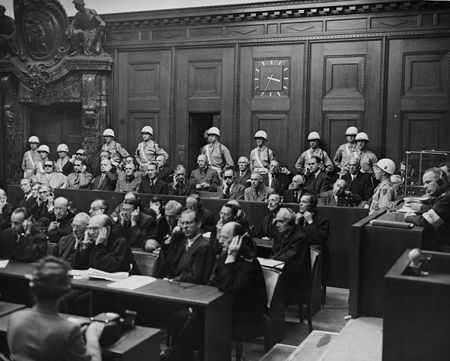Nuremberg Trials: Difference between revisions
imported>Howard C. Berkowitz No edit summary |
mNo edit summary |
||
| (3 intermediate revisions by one other user not shown) | |||
| Line 66: | Line 66: | ||
*[[Constantin von Neurath]] | *[[Constantin von Neurath]] | ||
*[[Martin Bormann]] | *[[Martin Bormann]] | ||
*[[Hjalmar Schacht]] (acquitted) | *[[Hjalmar von Schacht]] (acquitted) | ||
*[[Franz von Papen]] (acquitted) | *[[Franz von Papen]] (acquitted) | ||
*[[Hans Fritzsche]] (acquitted) | *[[Hans Fritzsche]] (acquitted) | ||
| Line 82: | Line 82: | ||
*[[Schutzstaffel | The SS]] | *[[Schutzstaffel | The SS]] | ||
*[[Sicherheitsdienst | The SD (Security Service)]] | *[[Sicherheitsdienst | The SD (Security Service)]] | ||
{{col-break|width=50%}} | |||
*[[Gestapo | The Gestapo (Secret State Police)]] | *[[Gestapo | The Gestapo (Secret State Police)]] | ||
*[[Sturmabteilung | The SA (Stormtroopers)]] | *[[Sturmabteilung | The SA (Stormtroopers)]] | ||
*The General Staff and High Command of the German Armed Forces | *The General Staff and [[Oberkommando der Wehrmacht|High Command of the German Armed Forces]] | ||
|} | |} | ||
==References== | ==References== | ||
{{reflist}} | {{reflist}}[[Category:Suggestion Bot Tag]] | ||
Latest revision as of 11:01, 27 September 2024
The International Military Tribunal (IMT) in Nuremberg, more commonly known as the Nuremberg Tribunal, was established by the four major Allied powers in Europe, convened as the Allied Control Commission. Its function was to try the Major War Criminals (i.e., the term used in the indictment) of Nazi Germany, as well as determining whether certain Nazi organizations were to be considered as criminal conspiracies of which membership was a crime. It complemented the International Military Tribunal (Tokyo) of the Major War Criminals of the Empire of Japan, and was followed by a series of Nuremberg Military Tribunals conducted by the United States.
This was an unprecedented event in international law. [1] It was not a conventional trial, and there was no body of international law to guide it. Few would argue that many of the charges were ex post facto, for offenses, such as crimes against humanity, which were not recognized in international law at the time they were committed. Some of the offenses, such as crimes against peace, arguably violated the Kellogg-Briand Pact, but that treaty did not prescribe enforcement.
One argument for the trials' legitimacy stated:
"It has been argued that the Tribunal cannot be regarded as a court in the true sense because, as its members represent the victorious Allied Nations, they must lack that impartiality which is an essential in all judicial procedure. ... As no man can be a judge in his own case, so no allied tribunal can be a judge in a case in which members of the enemy government or forces are on trial. Attractive as this argument may sound in theory, it ignores the fact that it runs counter to the administration of law in every country. If it were true then no spy could be given a legal trial, because his case is always heard by judges representing the enemy country. Yet no one has ever argued that in such cases it was necessary to call on neutral judges. The prisoner has the right to demand that his judges shall be fair, but not that they shall be neutral. As Lord Writ has pointed out, the same principle is applicable to ordinary criminal law because 'a burglar cannot complain that he is being tried by a jury of honest citizens." [2]
Planning and conduct
While the Allies had, for some time, been discussing how to handle the leaders of the Third Reich, the formal IMT opened in Berlin on October 18, 1945. Proceedings began in Nuremberg on November 14, 1945, and ended with the sentences on October 1, 1946.
Convicted defendants condemned to death were subsequently executed, at Nuremberg, on October 16, 1946.[3] Those defendants subject to imprisonment were held at Spandau Prison in Berlin, which closed after the last prisoner, Rudolf Hess, died on August 17, 1987.
While the original idea was to have multiple trials, this broke down in four-power argument. Only the "Trial of the Major War Criminals" was conducted under the IMT. Subsequent war crimes trials were under the authority of individual major allied tribunals, such the U.S. Nuremberg Military Tribunals, or trials by occupied powers such as Poland.
In pursuance of the Agreement by the Government of the Union of Soviet Socialist Republics, the Provisional Government of the French Republic, the Government of the United States of America, and the Government of the United Kingdom of Great Britain and Northern Ireland for the prosecution and punishment of the major war criminals of the European Axis dated at London, 8 August 1945, and of Article 22 of the Charter annexed thereto constituting this International Military Tribunal, this meeting is held at Berlin for the reception of the Indictment under the Agreement and Charter.[4]
Defendants
Both individuals and organizations were on trial.
Individual
Not all the major war criminals were available to the Tribunal. Adolf Hitler, Heinrich Himmler and Joseph Goebbels, for example, had committed suicide. Reinhard Heydrich had been assassinated. Martin Bormann could not be found and was tried in absentia; more recent information indicates he had died before the end of the war.
Robert Ley was indicted but committed suicide before the trial began. Gustav Krupp was indicted but was never tried because of severe illness; the Tribunal rejected the prosecution's attempt to substitute his son, Alfried, as a defendant after the father had been found incompetent.
An opening session of the IMT was held at Berlin on 18 October 1945; the trial convened at Nuremberg on 14 November 1945 and concluded its business with the passing of sentence on nineteen of the twenty-two defendants on trial on 1 October 1946. The defendants were:
Organizational
|
